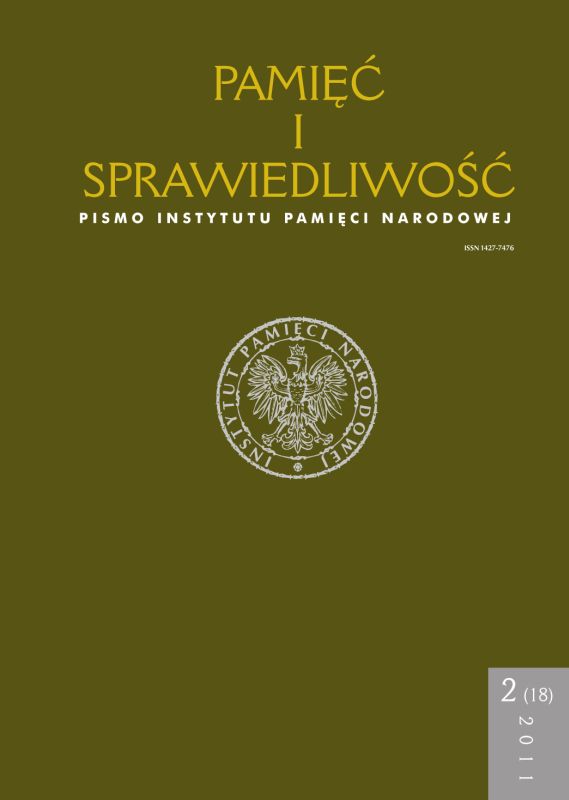Kierownictwo Polskiej Zjednoczonej Partii Robotniczej w latach 1986–1990. Szkic do portretu
Pamięć i Sprawiedliwość, Том 18 № 2 (2011), pages: 129-149
Publication date: 2011-12-30
Аннотация
Библиографические ссылки
T. Mołdawa, Ludzie władzy, Warszawa 1991 M.F. Rakowski, Dzienniki polityczne 1987–1990, Warszawa 2005 M.F Rakowski, Zanim stanę przed trybunałem, Warszawa 1992 Jerzy Urban [w:] Koniec epoki. Wywiady Maksymiliana Berezowskiego, Warszawa 1991 T. Młyńczak, Widziane z trzeciego planu, Warszawa 1992 A. Garlicki, Rycerze Okrągłego Stołu, Warszawa 2004 W. Wiśniewski, Dlaczego upadł socjalizm?, Warszawa 2006 M.F. Rakowski, Dzienniki polityczne 1984–1986, Warszawa 2005 A. Miodowicz, Zadymiarz, Warszawa 1993 M. Rakowski, Jak to się stało, Warszawa 1991 J. Urban, Alfabet Urbana, Warszawa 1990 W. Bereś, J. Skoczylas, Generał Kiszczak mówi... prawie wszystko, Warszawa 1991 K. Barcikowski, U szczytów władzy, Warszawa 1998 R. Wapiński, Świadomość polityczna w Drugiej Rzeczypospolitej, Łódź 1989 W. Sawicki, Współpraca Wojciecha Jaruzelskiego z organami Informacji Wojskowej w świetle materiałów wschodnioniemieckiej Stasi (studium źródłoznawcze), „Biuletyn IPN” 2010, nr 3, s. 97–109 H. Świda-Ziemba, Młodzież PRL. Portrety pokoleń w kontekście historii, Kraków 2010 A. Małkiewicz, Wybory czerwcowe 1989, Warszawa 1994
Наиболее читаемые статьи этого автора (авторов)
- Rafał Łatka, Mirosław Szumiło, Od Redakcji , Pamięć i Sprawiedliwość: Том 37 № 1 (2021)
- Rafał Łatka, Mirosław Szumiło, Od Redakcji , Pamięć i Sprawiedliwość: Том 36 № 2 (2020)
- Mirosław Szumiło, „Żydokomuna” w aparacie władzy „Polski Ludowej”. Mit czy rzeczywistość? , Pamięć i Sprawiedliwość: Том 32 № 2 (2018)
- Mirosław Szumiło, Biografický slovník vedoucích funkcionářů KSČ (1921–1989), t. 1: A–K, t. 2: L–Z, red. Petr Anev, Matěj Bílý, Nakladatelství Academia, Ústav pro studium totalitních režimů, Praha 2018, 732 s. , Pamięć i Sprawiedliwość: Том 36 № 2 (2020)
- Mirosław Szumiło, Protegowani Jakuba Bermana jako przykład klientelizmu i nepotyzmu w elicie władzy PRL. , Pamięć i Sprawiedliwość: Том 34 № 2 (2019)
- Mirosław Szumiło, Konflikty w kierownictwie PZPR w świetle dokumentów sowieckich z 1969 roku. Przyczynek do genezy upadku ekipy Władysława Gomułki , Pamięć i Sprawiedliwość: Том 30 № 2 (2017)
- Mirosław Szumiło, [Recenzje] Janusz Królikowski, Generałowie i admirałowie Wojska Polskiego 1943–1990, t. 1–4, Wydawnictwo Adam Marszałek, Toruń 2010 , Pamięć i Sprawiedliwość: Том 20 № 2 (2012)
 Język Polski
Język Polski
 English
English
 Deutsch
Deutsch
 Français (France)
Français (France)
 Italiano
Italiano
 Русский
Русский


 PDF (Język Polski)
PDF (Język Polski)
